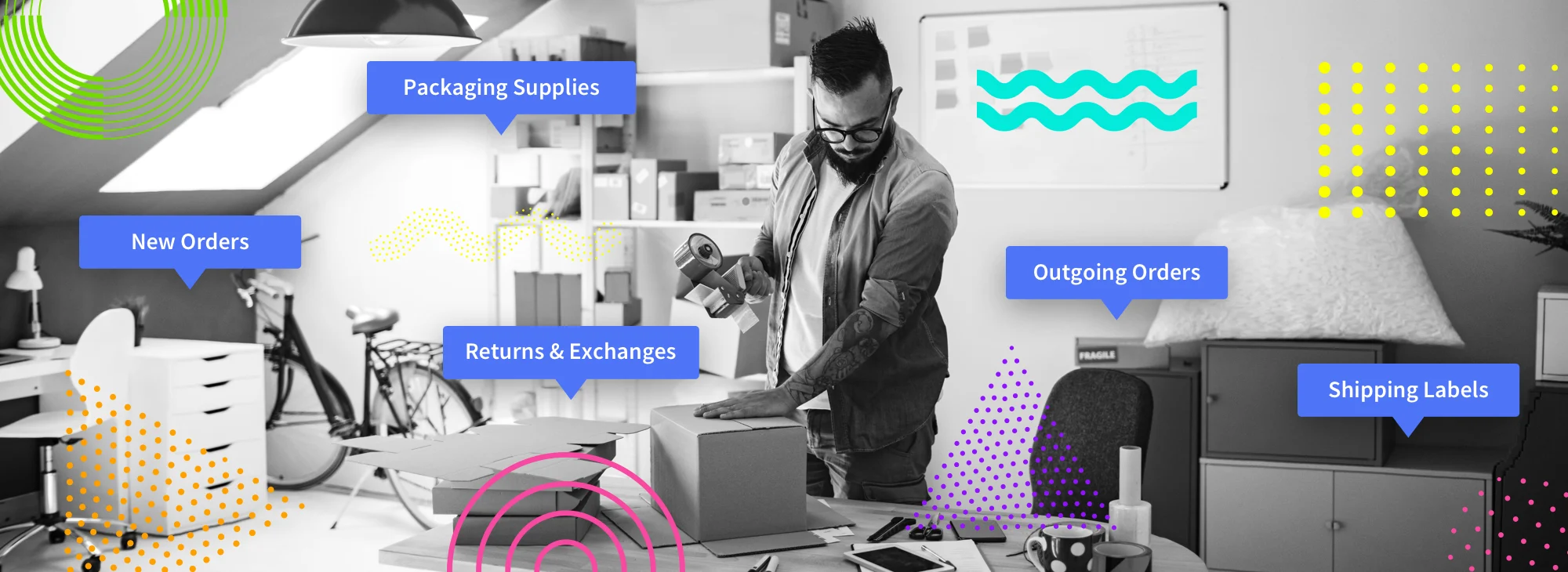How to Maximize Warehouse Efficiency For Your Ecommerce Merchandise

Where do you store inventory?
In your living room or garage? At a leased warehouse space? With a third-party provider?
As an ecommerce merchant, warehousing is a critical piece of your supply chain. Good ecommerce warehouse management can save you money and time and keep your customers happy.
Too often, though, planning for warehousing and storage falls by the wayside in favor of more exciting pre-launch activities. Read on to learn why ecommerce warehousing matters — and what you should do about it.
What is Ecommerce Warehousing?
Ecommerce warehousing is the storage of physical goods before they are sold online. Warehousing includes safely and securely storing products, as well as tracking where items are located, when they arrived, how long they’ve been in stock, and the quantity on hand at any given time.
What is Ecommerce Warehouse Management?
Ecommerce warehouse management refers to daily warehouse operations, including (but definitely not limited to!):
Training and managing warehouse staff.
Managing inventory, equipment, and safety.
Building and maintaining relationships with shipping carriers.
Keeping products secure.
Forecasting shipping volume and labor demand.
Obtaining certifications and licensing.
Scaling operations as the business grows.
Keeping up with proper safety regulations.
Recording daily inbound and outbound shipments.
And much, much more.
A lot of time and resources go into effective ecommerce warehouse management. But many businesses still try to do it all themselves by keeping ecommerce warehousing in-house. Keep reading to learn why.
Why Many Ecommerce Warehouses Are Garages or Living Rooms
When you started your online store, did you have the bulleted list above in mind?
For many merchants, the answer is no. Often, this results in garages, living rooms, and basements stacked floor-to-ceiling with product.
1. Business operates from home.
If your entire ecommerce business operates from home, it makes sense to store products on-site — at first. This allows you to keep an eye on your stock, pack and ship orders right from home, and receive new inventory right to your front door. As your order volume increases, however, so should your on-hand stock — and you might find yourself buried in boxes.
2. Warehousing costs too much.
For small businesses, ecommerce warehousing can cost more than it’s worth, especially if you want full hands-on control over your warehouse. Leasing or purchasing warehouse space can be expensive. If you sell a wide variety of products, you need more storage space, making it even more pricey.
3. Owners feel they’re too small to outsource.
Many small businesses may not realize that warehousing is an option for their online stores. If a business is too small to buy or lease its own ecommerce warehouse, there are alternatives to keeping inventory in the garage or living room, such as warehousing through a third-party service. Merchants may not realize that options like this exist for smaller players, not just retail giants.
4 Benefits of Warehousing Your Ecommerce Products
Warehousing can benefit ecommerce businesses of all sizes. Here are four benefits of using external warehousing for your products.
1. Ship to your customers faster.
Thanks to the Amazon Prime Effect, online shoppers expect to receive their orders quickly and affordably every time they shop online.
When choosing where to store your inventory, consider distributing it to multiple warehouses across the country. This can help place your inventory closer to more of your customers, meaning it takes less time (and money) for their online orders to reach them.
2. Better organization of products.
Warehouses are designed to store products. Your living room, garage, and guest room aren’t.
Ecommerce warehousing can improve the accuracy of inventory tracking and prevent lost items.
With the right warehouse management system in place, this can help you track inventory turnover rates and proactively reorder inventory.
3. Less stress.
Ecommerce warehousing goes way beyond shelving products; taking the laundry list of warehousing responsibilities off your plate can be a huge relief. A more organized process and knowing that your products are in good hands can make a huge difference.
(Having room to park in your garage again doesn’t hurt, either.)
4. Time savings.
For ecommerce merchants, time is a precious resource. Freeing up the time spent on searching through piles of products or playing storage Tetris allows you to focus instead on growing your business. Oftentimes, the time savings can offset the costs of warehousing; after all, time is money.
What Happens Without Ecommerce Warehouse Management
Whether you store inventory at home or lease warehouse space, things can quickly go awry if you don’t have the proper warehouse and inventory management systems in place. Here’s what can happen if you don’t have proper warehouse management in place:
1. Inventory gets lost.
An ecommerce warehouse management system keeps track of the storage location of every product variation on your site. Without this technology in place, inventory can be misplaced, especially as your business and product catalog grow.
2. Wrong inventory gets shipped.
If you’re not keeping careful track of your inventory, you may accidentally end up shipping the wrong items to your customers. This can keep first-time customers from coming back and drive loyal customers away.
Investing in warehouse management can have a positive impact on your bottom line by creating a better customer experience.
3. Storage runs out.
Many small businesses find themselves running out of space at home to store inventory. For example, Noel Churchill of Rainbow OPTX ran into this issue as his sunglasses brand grew:
“My garage was at maximum capacity — we couldn’t even fit another person in there. I could have leased a warehouse somewhere and grown into the space, but with the seasonal nature of our business, meaning we’d have to scale up our fulfillment and workforce every year, I knew I had to find a 3PL partner.” -Noel Churchill, Owner and CEO of Rainbow OPTX
4. Stock-outs or over-purchasing inventory.
Strategic ecommerce warehouse management helps you figure out how much inventory you should have on hand. Too little inventory can result in stock-outs — and missing out on potential online sales. Too much inventory and you risk having outdated inventory on hand that you can no longer sell.
Excess inventory can also lead to spending too much money on storage. Managing your inventory levels strategically can help you re-allocate those funds.
Ecommerce Warehousing With a 3PL

One way to streamline your ecommerce supply chain — warehousing included — is by outsourcing logistics to a third-party logistics (3PL) provider. Working with a 3PL allows you to automate and manage all of your ecommerce logistics processes through one partner, including warehousing, inventory management, order fulfillment, and more.
Here are some of the benefits of outsourcing ecommerce warehousing and fulfillment to a 3PL.
1. Ecommerce integration.
Many 3PLs integrate directly with major ecommerce platforms like BigCommerce. As soon as an order is placed on your online store, the details are passed on to a 3PL’s warehouse or fulfillment center. Then, the order is picked, packed, and shipped to the customer from the warehouse.
This connection also allows inventory counts to be automatically synced between the 3PL’s software and your online store.
2. Ship easily on major marketplaces.
In addition to ecommerce platforms, some 3PLs also integrate with major online marketplaces. If you sell on Amazon, eBay, or Walmart, you can automatically sync your orders and inventory. This is especially useful if you sell on multiple platforms — store, manage, and track your inventory all through one provider and software.
3. Order tracking.
Once your 3PL ships an order, tracking info is pushed back to your ecommerce store and shared with the customer. This helps keep your customers in the loop from the moment they place an order through when it arrives on their doorstep.
4. Inventory management.
Since they store and ship your products for you, a 3PL can take inventory management off your plate. This includes tracking inventory levels, ordering and restocking inventory, and forecasting future demand.
Many 3PLs offer built-in inventory management software to streamline and automate the process. Good inventory management software allows you to prepare for various levels of demand and sales by monitoring trends and historical patterns.
5. Scale with your growth.
As your online store grows and order volume increases, you’ll need more space to store your inventory and more staff to manage ecommerce fulfillment. Working with a 3PL ensures that you have room to grow — literally and figuratively.
The co-founders of workout apparel brand FLEO shorts learned the importance of choosing a scalable 3PL the hard way:
“Before ShipBob, we used a fulfillment center that frankly couldn’t scale with us. Since moving to ShipBob we’ve grown 30% year over year, which is a testament to their scalability, service, and technology. I feel really fortunate to have found ShipBob when we did.” – Carl Protsch, Co-Founder of FLEO
6. Faster order fulfillment.
Thanks to the expectations set by Amazon Prime, customers want their orders delivered fast and free wherever they shop online. If you’re shipping from home or a rural fulfillment center, fast shipping can be expensive. You either have to eat those costs or choose to pass them onto your customers. It’s kind of a lose-lose.
Choosing a 3PL with multiple warehouse locations can make a huge difference in your ability to ship orders quickly and affordably. By storing inventory in distribution centers closer to more customers, orders have less distance (aka fewer shipping zones) to travel, making shipping faster and more affordable.
Conclusion
In all the excitement and stress of running an online store, ecommerce warehousing can get forgotten. It’s a key piece of the ecommerce puzzle and can make a big difference to your bottom line.
Good inventory and warehouse management for your online store can help you save money and time while meeting customer expectations. Whether you store inventory in-house or partner with a 3PL, keep the tips and strategies in this post in mind for a better warehousing experience.

Kristina Lopienski is the Content Marketing Manager at ShipBob. ShipBob allows ecommerce businesses to strategically distribute their inventory to our fulfillment centers across the US. By shipping orders out from near where their customers reiside, they can reduce transit times and shipping costs by leveraging ground shipping.


